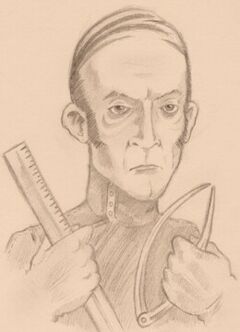Findthee Swing
| Captain Findthee Swing | |
 | |
| Name | Findthee Swing |
| Race | Human |
| Age | |
| Occupation | Captain of the Cable Street Particulars |
| Physical appearance | Small, thin, pale, balding with hair swept over to cover and screwed up eyes like a pet rat |
| Residence | Ankh-Morpork |
| Death | At the hands of Sam Vimes, well, the ruler |
| Parents | |
| Relatives | |
| Children | |
| Marital Status | |
| Appearances | |
| Books | Night Watch |
| Cameos | |
Captain Findthee Swing ("please smirk now if you find it amusing") was the boil on the top of the seething lake of pus created by the rule of the grotesque Lord Winder. He ran the Unmentionables during this latter's reign. The Unmentionables were pretty much the Gestapo of Ankh-Morpork: you didn't dare get noticed by them, you didn't dare complain, and you most certainly didn't argue. Those few people who managed to walk out of their clutches in Cable Street seemed to have fingers pointing the wrong way or lumps and burns that they couldn't quite explain (horrible echoes of Room 101 from Orwell's 1984).
After being trained at the Assassins' School, he impressed Winder with his theories, although he hadn't invented craniometrics yet. At first, he joined the City Watch, and became later head of the Unmentionables. Winder found him to be a useful tool, because nobody could sniff out consipiracies like him.
His Weapons Law would have cut down crime, but, alas, criminals don't obey the law. However, as a result, many honest citizens, carrying weapons for their protection after dark, were arrested in large numbers. Of course, this added to the unrest in the city, but Swing was happy about the rising arrest rates.
Swing, who had a mind that "had arrived at thuggery by the long route and was capable of devising in the name of reason the kind of atrocities that unreason could only dream of", invented then craniometrics. Take it away Terry: "Bad coppers had always had their ways of finding out if someone was guilty. Back in the old days - hah, now - they included thumbscrews, hammers, small pointed bits of wood, and, of course, the common desk drawer, always a boon to the copper in a hurry. Swing didn't need any of this. He could tell if you were guilty by looking at your eyebrows."
"He measured people. He used calipers and a steel ruler. And he quietly wrote down the measurements, and did some sums, such as dividing the length of the nose by the circumference of the head and multiplying it by the width of the space between the eyes. And from such figures he could, infallibly, tell that you were devious, untrustworthy, and congenitally criminal. After you spent the next twenty minutes in the company of his staff and their less sophisticated tools, he would, amazingly, be proven right."
He dies very satisfactorily during the revised events of Night Watch, when Sergeant-At-Arms John Keel (impersonated by Sam Vimes) and he have a set-to, Swing with his swordstick and Keel with one of Swing's own steel rulers for measuring people up. Keel manages to hit him in the throat and clearly breaks his larynx, which is invariably fatal. Shame, but it gives him the once-in-the-lifetime, ahem, -afterlifetime chance to try his craniometrics on Death.
All of this is related in Night Watch.
Annotation
The name "Captain Swing" has been previously associated with civil unrest. During the Swing Riots in 19th Century Britain, many protestors sent threatening messages to landlords and magistrates, signed with the name "Captain Swing".
Horrifyingly, on Roundworld, craniometrics was also entirely true: scientists a hundred years ago used it not only to hunt for criminal types in the human population, but also to "prove" a correlation between physiognomy and intelligence. This led directly to eugenics and justifications for segregation. Craniometrics was extensively used by the Nazis to provide theoretical plausibility for their ideas. A whole department of Heinrich Himmler's SS - the Racial Purity Bureau - was given over to taking the facial measurements by which the world was divided into Aryans and varying degrees of untermenschen. In Poland and other occupied countries, if a child's facial measurements "proved" that it really belonged to the Aryan race, then that child could be removed from its unworthy Slavonic parents to be brought up by a German family. Conversely, in cases of doubt as to parentage or race, an unfavourable set of craniometrics was a ticket to a death camp.
Prinz-Albrecht Strasse in Berlin, where the Gestapo had its headquarters, is an unremarkable airy suburban street with the usual genteel Berliner mix of shops and offices downstairs, flats and apartments on upper floors. Number 54 is as unremarkable as any other address on the street - at least today... No doubt Cable Street, whose other notable premises are Gimlet's dwarf delicatessen, a betting shop, and the upstairs Temple of Anoia, would have looked just as unremarkably suburban.
It occurs to me that in Tom Sharpe's two novels set in apartheid South Africa, Riotous Assembly and Indecent Exposure, which centre around the grossly incompetent and disorganised Piemburg Police Force, one of the memorable characters is the deranged secret policeman Luitenant Verkramp. As one of his duties is enforcing the apartheid laws, Verkramp agonises about precise differences between black and white people and spends time with a predatory German psychiatrist devising all sorts of tests and measurements to ascertain, among other things, the degree of racial contamination present in otherwise white people whose ancestry might conceal an embarrassing inter-racial slip or two...
In general, the South African Police Force as portrayed by Sharpe is an analogue of the Night Watch as we know and love it, but shorn of any graces or redeeming features whatsoever. Another influence on Pratchett?